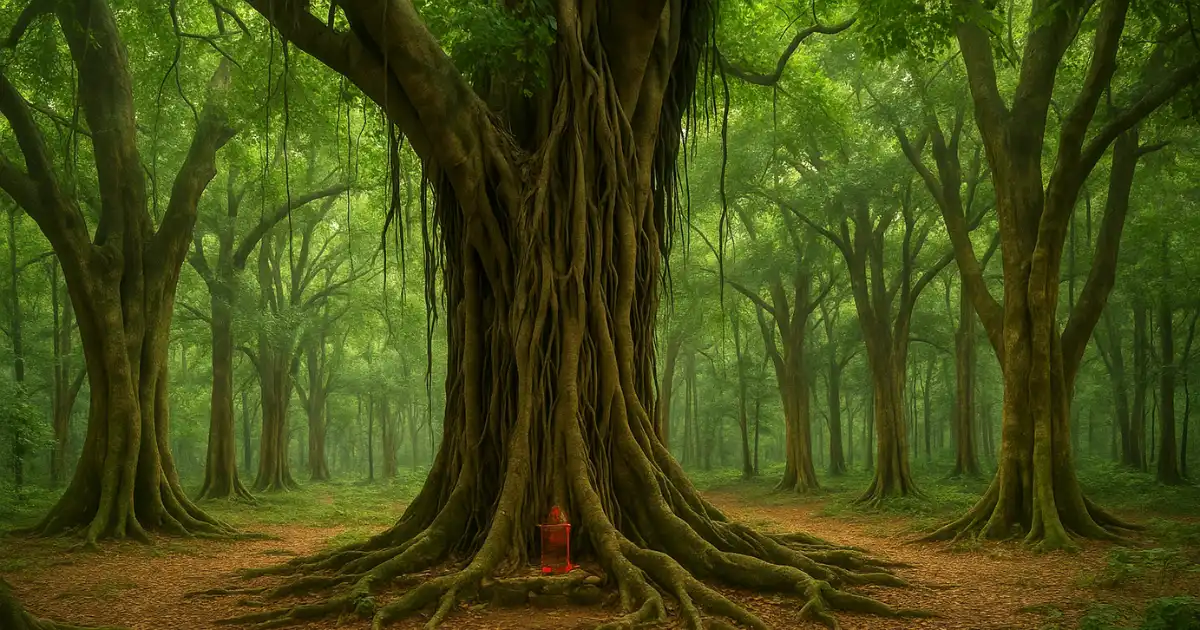Ramachandra Guha’s recent book Speaking with Nature: The Origins of Indian Environmentalism argues that environmentalism is a modern invention, born out of industrial-era anxieties and post-Enlightenment political ideologies. While this may hold for the trajectory of environmental politics in the West, such a claim cannot be uncritically applied to the Indian civilizational experience. Environmentalism, though a modern lexical construction, has never been foreign to Indian consciousness. This article critically engages with Guha’s assertions, examining them through the lenses of ancient Indian texts, local traditions, ecological ontologies, and contemporary ethnographic realities. The argument presented here is not only a call for reinterpreting Indian environmental history but also an invitation to global scholarship to engage with Indian ecological wisdom as an alternative paradigm - one in which humans and nature are entangled in a relational, moral, and cosmic order.
The Myth of Modern Environmentalism
Guha begins his book with a provocation: that environmentalism, as we know it, is a product of industrial modernity. He argues that the ecological dislocations caused by coal, steel, and urban expansion in the 19th century birthed environmental consciousness. What this framing misses, however, is that it reflects a distinctly Western experience, where the rupture between nature and human society required an ideological and political response. It is undeniable that the term environmentalism is of modern coinage, and the very framing of environmentalism as an ism, a reactionary movement against industrialization, is deeply rooted in Western historical experience. But the philosophical orientation it represents - a deep concern for the interrelation of human and ecological systems - is ancient in India, where nature was never seen as external to the human; and hence, did not require a movement to protect it.
In the Indian context, no such rupture historically existed. Nature was not perceived as an externality to be managed or conquered, but as an extension of the self. The Earth was not merely a resource; she was Bhūmi Devī, a living deity.
The idea of ecological responsibility, therefore, did not emerge as a reactive movement but was embedded as an ethical orientation in both spiritual life and daily practice.
The absence of a term like “environmentalism” in classical India does not imply the absence of ecological ethics. It simply reflects a worldview where the sacred and the ecological were not imagined as separate realms, but nurtured by the civilizational imagination of the ṛta-dharma-prakṛti continuum.
Ecology as Ontology: The Vaidika and Upaniṣad Imagination
One need only turn to the Vaidika corpus to witness the foundational ecological orientation of Indian thought. The Atharvaveda contains an entire hymn, the Bhūmi Sūkta, dedicated to Goddess Earth. It opens with the declaration:
माता भूमिः पुत्रोऽहं पृथिव्याः mātā bhūmiḥ putro'haṃ pṛthivyāḥ
The Earth is my mother; I am her son. Atharvaveda XII.1.12
The Ṛgveda declares in 5.84.14:
पृथिवी पूषा पयस्वती मा मा हिंसीः परमे व्योमन्
pṛthivī pūṣā payasvatī mā mā hiṁsīḥ parame vyoman
May the nourishing Earth not harm me in the vast heavens.
We also have a similar description in the Bhaviṣya Purāṇa -
शुद्धकाञ्चनवर्णाभां वराभयकरां शुभां। मण्डूकस्थां च द्विभुजां सर्वालङ्कारसुन्दरीम्॥ भविष्य पुराण - २-३-१-३९
śuddhakāñcanavarṇābhāṃ varābhayakarāṃ śubhāṃ। maṇḍūkasthāṃ ca dvibhujāṃ sarvālaṅkārasundarīm॥
She shines with the pure radiance of gold. She holds the gestures of granting boons (vara) and dispelling fear (abhaya), and she is auspicious (śubhāṃ). She is seated in the posture of a frog (maṇḍūkasthā), and she has two arms (dvibhujām). She is adorned with all ornaments, and her beauty is unparalleled (sundarīṃ). Bhaviṣya Purāṇa - 2-3-1-39
This prayer is not anthropocentric, but relational: humans are one among many recipients of the Earth’s grace. The thought articulated here is a civilizational ethic where the Earth is personified as a being- a mother who nourishes, sustains, and deserves reverence. The hymn goes on to describe the Earth’s mountains, herbs, rivers, and creatures with reverence and reciprocity.
Similarly, the Ṛgveda invokes elemental forces as deities - Agni, Vāyu, Soma, Varuṇa - not in abstraction, but as vital presences within a web of relations. The Taittirīya Upaniṣad affirms this continuity through its ecological grammar:
अन्नं न निन्द्यात् | annaṃ na nindyāt || Do not speak ill of food. - Tai. Up. 3.7.1 अन्नं न परिचक्षीत | annaṃ na paricakṣīta || Do not waste food. - Tai. Up. 3.8.1 अन्नं बहु कुर्वीत | annaṃ bahu kurvīta || Let food be plentiful and shared. - Tai Up. 3.9.1.
We see here that food is not mere sustenance. It is annam, a sacred substance infused with cosmic significance. The Upaniṣadic sages viewed all existence as interconnected layers of being: annamaya, prāṇamaya, manomaya, vijñānamaya, and ānandamaya. Nature was not ‘out there’ somewhere. It was, and is, within.
Furthermore, Indian philosophical traditions, including Sāṅkhya, Vaiśeṣika, Jain, and Bauddha schools, developed systematic ontologies where the material world (prakṛti) was not considered inert matter, but animated by sentience, intentionality, and rhythm. Hence, the concept of ahiṃsā extended not only to animals but also to trees, water, wind, and soil.
Misreading the Mahābhārata: The Forest as Moral Mirror
Guha’s assertion that the Mahābhārata celebrated the destruction of forests rests on a serious misreading of the Khāṇḍava-dāha episode. Far from being a triumphalist account of environmental conquest, the burning of the Khāṇḍava forest is framed within the epic as a moment of civilizational rupture: a morally fraught act with deep ecological, spiritual, and cosmic consequences.
And neither does the Mahābhārata present the forest as an empty or inert wilderness. As the accompanying narrative notes, the Khāṇḍava forest was once a vibrant divya-kṣetra, inhabited by gods, yakṣas, gandharvas, nāgas, and sages. It was not a space awaiting development, but a sacred ecology teeming with life and meaning. King Sudarśana’s earlier attempt to assert dominion over it provoked Indra’s wrath and led to the forest’s rewilding.
This cycle of destruction and regeneration hints at the forest's sanctity and the dangers of hubris.
When Kṛṣṇa and Arjuna later set fire to the Khāṇḍava forest to make way for Indraprastha, the act is rendered with discomfort, even dread. The forest is not silent; it screams. The narrative is filled with the cries of fleeing serpents, panicked animals, and anguished sages. Even the gods are troubled. There is no unambiguous celebration here; there is only a complex grappling with power, violence, and the costs of civilization.
Importantly, the epic does not allow this transgression to go unresolved. The Mahābhārata repeatedly sends its heroes back into the forest, not merely as punishment, but as pedagogy. The vana is not the antithesis of culture; it is its moral axis, a śikṣābhūmi where the Pāṇḍavas must unlearn their arrogance and relearn dharma from ascetics, animals, and the rhythms of the wild. The destruction of Khāṇḍava forest is thus not a tale of progress, but of excess - a lesson in the consequences of violating the sacred order of the world.
To invoke the Khāṇḍava-dāha as a celebratory blueprint for forest destruction today is not only textually inaccurate but intellectually irresponsible. It erases the epic’s deeply civilizational concern with balance, restraint, and reverence for the more-than-human world.
Sacred Groves and Vernacular Ecologies
The Indian environmental tradition is not confined to texts. It lives in the soil, rivers, and rituals of ordinary people. Across the country, sacred groves - known as devrāīs in Maharashtra, kāvu in Kerala, and orans in Rajasthan - have long served as community-protected biodiversity reserves. These groves are dedicated to local deities and often contain rare medicinal plants, water sources, and wildlife.
Unlike modern conservation parks, these spaces are not protected through fences or fines. They are preserved through faith, story, and ritual. Anthropologist Madhav Gadgil has shown how such groves demonstrate a “folk ecology,” where conservation is embedded in everyday life and cosmology rather than imposed through legal instruments.
Moreover, the Bishnoi community in western Rajasthan, following the teachings of Guru Jambheshwar since the 15th century, has institutionalized ecological ethics through 29 principles. These include bans on tree felling, animal killing, and pollution of water bodies. Their sacrifice during the 1730 Khejarli massacre, where over 360 Bishnois gave their lives to protect trees, is among the earliest acts of ecological resistance in the world.
Similarly, during the Kol Uprising (1831–32) and the Santhal Hul (1855–56), the forests of Chotanagpur and Santhal Parganas were not just battlegrounds - they were sacred geographies. The British intrusion was seen not only as a political conquest but also as a profanation of sacred forests, spirits (bongas), and ancestral lands. In one documented account during the Santhal rebellion, tribal leaders are said to have refused to coat their arrows with poison, despite being vastly outnumbered and outgunned, because such violence would “offend the forest spirits who gifted them the trees and the herbs” (Kujur, 2019).
This refusal was not weakness but cosmic ethics. For the Santhals and Mundas, harming the enemy with nature’s sacred gifts - poisonous herbs or sacred tree sap - was a form of adharma. In resisting colonization, they also refused to sever their ecological ethics for strategic advantage.
As Joba Murmu (2017) has explained, “The forest is not just a resource. It is a relation—an ancestor, a mother. Even in war, one does not betray one’s kin.”
Chipko and Beyond: Cultural Roots of Modern Movements
When the women of Reni village in Uttarakhand embraced trees during the Chipko movement of the 1970s, their act was not a spontaneous protest inspired by environmental activism abroad. It was a continuation of cultural memory. These were women who sang songs to trees, who believed that a tree felled was a limb severed. Their protest was rooted not in ideology, but in bhāva - the affective, embodied relationship with nature passed down through generations.
Similar eco-ethical resistance emerges in the oral narratives of the Khasi and Mizo peoples of the Northeast. When British forces began expanding roads and tea plantations in the mid-19th century, resistance came not only in the form of armed conflict but also through ritual fasts, forest mourning, and symbolic gestures of severance from violated sacred groves. Khasi elders, as recorded in colonial ethnographic surveys, would perform Ka Niam Tre rituals (sacred grove invocation rites) to warn against the desecration of forest land, calling it an invitation to drought, disease, and cosmic disorder (Sen, 2012).
The Lushai Hills witnessed uprisings led by chiefs like Lalthuama and Chawngbawla, who viewed the burning of forests for commercial gain as not just economic dispossession, but also as an attack on the moral order of the universe, in which humans and non-humans were co-sustaining beings (Baruah, 2005).
Scholar Vandana Shiva rightly notes that “ecology is not a new science in India, it is a lived reality.” Environmental ethics were not formulated as abstract doctrines, but enacted through festivals, taboos, agricultural practices, and pilgrimage.
Environmentalism as a Way of Being: Lessons for the World
Guha’s framework, while valuable for charting the history of forest policy under colonialism and post-independence development, remains constrained by its attachment to Western categories of politics and modernity. His reliance on textual cynicism - questioning the sincerity of Vaidika hymns, and dismissing the significance of sacred groves - reflects a modernist suspicion of indigenous knowledge systems.
Such a view fails to engage with the complex epistemologies of Indian civilization, where knowledge is transmitted through śruti, smṛti, ṛta, and līlā. It also neglects the fact that colonization did not merely exploit Indian forests; it redefined the very meaning of nature in India, transforming living ecologies into commercial timberlands, and sacred rivers into drainage systems.
Decolonizing and reclaiming environmental history requires more than expanding the timeline of ecological concern. It requires a shift in metaphysics. It demands that we see prakṛti not as a backdrop to human drama, but as an agent, a teacher, and a companion.
Conclusion: Listening with Nature
Indian civilization never invented environmentalism because it never forgot the environment. The relationship between humans and nature was not contractual but filial. The Earth was not protected because it was in crisis; it was revered because it was sacred.
Modernity, in its attempt to dominate nature, had to invent environmentalism to save it. India, in its refusal to separate humans from the more-than-human world, has sustained ecological balance as a way of life.
This is not romanticism. It is a lived civilizational truth, still visible in the fields of Tamil Nadu, the forests of Bastar, the water temples of Gujarat, and the stories of the Purāṇas.
The time has come to reverse the gaze. The world, grappling with a planetary crisis, must stop asking how India can learn from the West’s environmental movements. It must begin by asking what India already knows.
References
- Baruah, S. (2005). Durable disorder: Understanding the politics of Northeast India. Oxford University Press.
- Eck, D. L. (2012). India: A sacred geography. Harmony.
- Gadgil, M., & Guha, R. (1992). This fissured land: An ecological history of India. Oxford University Press.
- Kujur, R. (2019). Forest, land, and the Santhal Hul: Ecological ethics and anti-colonial resistance. Adivasi Studies Review, 14(2), 53–68.
- Krishna, N. (2014). Sacred plants of India. Penguin Books India.
- Khanna, M. (1999). The cultural landscape of Hinduism. Indira Gandhi National Centre for the Arts.
- Murmu, J. (2017). The forest remembers: Cosmology, justice, and mourning in Santhal oral traditions. Oral History Association of India Journal, 5(1), 24–39.
- Prime, R. (2002). Vedic ecology: Practical wisdom for surviving the 21st century. Mandala Publishing.
- Sen, S. (2012). Colonial knowledge and the environment in India, 1850–1920: The case of forests. Indian Historical Review, 39(1), 1–20.
- Shiva, V. (1988). Staying alive: Women, ecology, and development. Zed Books.
- Thapar, R. (Ed.). (1996). Forests and settlements in Indian history. Oxford University Press.
- Taittirīya Upaniṣad. (c. 1000 BCE). In Principal Upaniṣads (trans. S. Radhakrishnan). HarperCollins, 1992.







